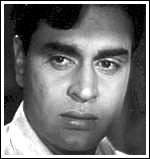
HOME | MOVIES | FEEDBACK |

When 1960s star Sadhana was hesitant about signing director H S Rawail's Mere Mehboob (Rawail's last release, the Dev Anand-Waheeda Rehman starrer Roop Ki Rani Choron Ka Raja, had proved a box-office dud), Hrishikesh Mukherjee advised her to accept the offer.
His rationale was simple --- Rajendra Kumar had agreed to be part of Mere Mehboob, and Kumar's acumen in spotting winning films had been vindicated time and again.
Yes, there was a phase between 1959 and 1966 when most films starring Rajendra Kumar proved huge successes. Courtesy his Midas touch, he was conferred the famous nomenclature of 'jubilee star'.
Golden streaks rarely come more lustrous --- Rajendra Kumar had an incredible six consecutive hits with not a single flop between late 1963 to 1966: Mere Mehboob [1963]; Zindagi, Sangam and Ayee Milan Ki Bela [all 1964]; Arzoo [1965] and Suraj [1966].
When he began his career, Rajendra Kumar benefitted because producers wanted a tragedian in the Dilip Kumar mould at an affordable price. Rajendra fitted the bill, both literally and figuratively, perfectly.
Later, Kumar made millions thanks to his penchant for onscreen tragedy (where would he be without his handy bottle of glycerine?) and his ability to charm women in musical romances with his bashful smile that invariably reached his lovelorn eyes. His gestural style of acting (watch him flailing his arms in Ek sawal mein karoon in Sasuraal) became a signature, as did his quivering lips and emotion-laden voice (see him crying at his mother's funeral in Talaash).
Rajendra's A-level stardom made him a mint and with his keen investment sense, he was reputedly one of the richest men in the industry of his time.
To think there was a time when R K Tulli (Rajendra Kumar before he was rechristened), born in Sialkot, had to trudge, with family in tow, for miles in the post-Partition days to reach Mumbai. After a stint as an assistant director to H S Rawail, Rajendra Kumar managed to get an uncredited role in Kidar Sharma's Jogan (starring his idol Dilip Kumar and Nargis). After half a decade of struggle, bigger roles in Vachan and V Shantaram's Toofan Aur Diya brightened his prospects.
Mehboob Khan (who had cast Rajendra in his production Aawaaz the previous year), brought him under the glare of the spotlight with Mother India. Though Rajendra's was the straight role of Nargis' obedient son, he played it earnestly and was flooded with films.
The actor who once starrred with Shyama and Kum Kum was now offered films with Meena Kumari and Mala Sinha.
But he had to wait for nine long years after his humble beginnings before he could power his own hits. He got a chance to blow his trumpet after Goonj Uthi Shehnai where he played the shehnai (an Indian wind instrument) with creditable verisimilitude. This Vijay Bhatt musical with tragic overtones and Vasant Desai's captivating compositions went on to become a hit.
1959 was a fortuitous year as Rajendra followed it up with the Meena Kumari three-tissue weepie Chirag Kahan Roshni Kahan and B R Chopra's Dhool Ka Phool.
After Rajendra had sportingly played the grey-shaded character of a man who ditches Mala Sinha to marry Nanda in Dhool Ka Phool, B R rewarded him with a memorable role as the crusading lawyer in his songless hit Kanoon [1960] next.
By now the hits were coming in an unceasing flow. The often-overwraught family melodramas like Sasuraal and Gharana [both 1961] were just what the doctor ordered for people who enjoyed a quiet weep.
Also in 1961 came the robust Aas Ka Panchi. which started two different but equally profitable partnerships --- with filmmaker Mohan Kumar (Ayee Milan Ki Bela, Aman, Anjana, Aap Aaye Bahar Ayee) and actress Vyjayanthimala (Sangam, Zindagi, Suraj, Saathi, Ganwaar).
Rajendra crystallised his martyr image with Dil Ek Mandir [1963], where he played a doctor who stakes his life to save the husband (Raaj Kumar) of her ex-love (Meena Kumari).
His lucky streak in the mid-1960s saw him embroiled in triangular romantic films with endless entanglements and starred either two heroes or two heroines. Case in point: Mere Mehboob (Sadhana, Ameeta), Ayee Milan Ki Bela (Saira, Dharmendra), Zindagi (Vyjayanthimala, Raaj Kumar), Arzoo (Sadhana, Feroz Khan) and of course the granddaddy of them all -- Sangam (Vyjayanthimala, Raj Kapoor).
Dilip Kumar was Raj Kapoor's first choice for Sangam [1964], but Rajendra made the role his own and eventually walked away with a major chunk of the sympathy. He complemented the flamboyant Raj Kapoor's extroverted emotionalism with surprising restraint and the right dose of anguish.
But just when he was at his zenith after Suraj, the sun began to slowly set on Rajendra's career. Whether it was Aman and Palki [1967], Jhuk Gaya Aasmaan and Saathi [1968] or Shatranj [1969], his films were disappointments.
He enjoyed a short-lived reprieve with the middle-level succeses of Anjana [in late 1969], and Talash, Geet and Ganwaar [all 1970]. But a new romantic icon Rajesh Khanna had arrived and stolen most heroes' female fans, Rajendra's included (ironically Rajendra Kumar had sold Rajesh Khanna his bungalow, Dimple).
The early 1970s saw the 40-plus Rajendra squandering his talents in indifferent films (save for Gora Aur Kala opposite his fan, Hema Malini). Rajendra wisely switched to character roles, predominantly for Sawan Kumar Tak (Saajan Bina Suhagan, O Bewafa and Saajan Ki Saheli).
In the early 1980s, he successfully launched his son, Gaurav, in Love Story. However, even when Gaurav's career ran aground, Rajendra continued making films with him even when he lost a small fortune on films like Lovers and Phool.
On July 12, 1999, Rajendra Kumar, an ace at playing a doctor grappling with life-threatening diseases (Dil Ek Mandir, Saathi), finally succumbed to cancer.
You might also want to read:
Design: Uday Kuckian
|
||
(c) 1996 - 2002 rediff.com India Limited. All Rights Reserved. |
|||